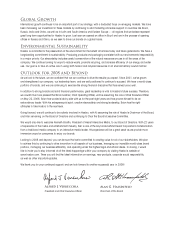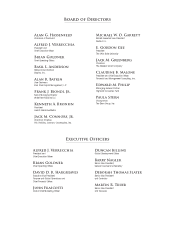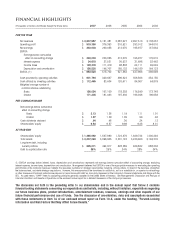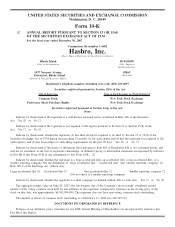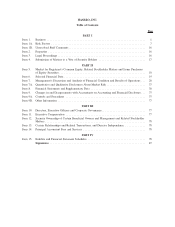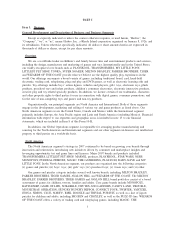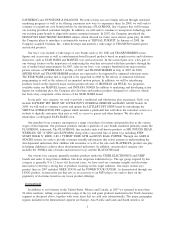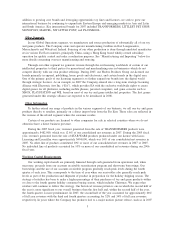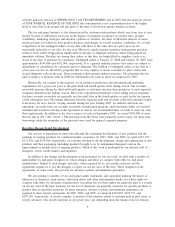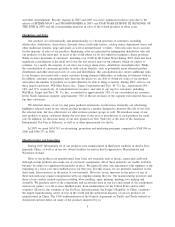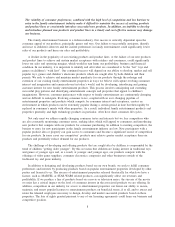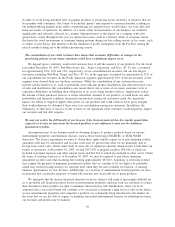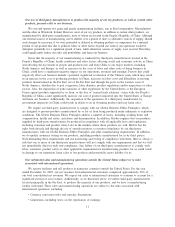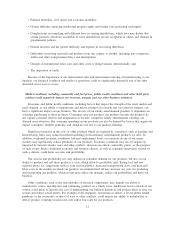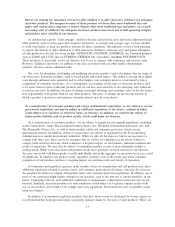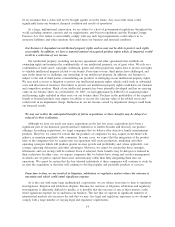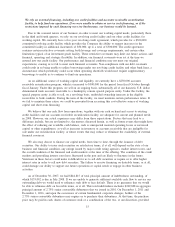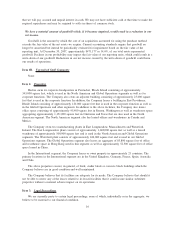Hasbro 2007 Annual Report Download - page 14
Download and view the complete annual report
Please find page 14 of the 2007 Hasbro annual report below. You can navigate through the pages in the report by either clicking on the pages listed below, or by using the keyword search tool below to find specific information within the annual report.
We believe that the manufacturing capacity of our third party manufacturers, together with our own
facilities, as well as the supply of components, accessories and completed products which we purchase from
unaffiliated manufacturers, are adequate to meet the anticipated demand in 2008 for our products. Our reliance
on designated external sources of manufacturing could be shifted, over a period of time, to alternative sources
of supply for our products, should such changes be necessary or desirable. However, if we were to be
prevented from obtaining products from a substantial number of our current Far East suppliers due to political,
labor or other factors beyond our control, our operations and our ability to obtain products would be disrupted
while alternative sources of product were secured. The imposition of trade sanctions by the United States or
the European Union against a class of products imported by us from, or the loss of “normal trade relations”
status by, the People’s Republic of China could significantly disrupt our operations and increase the cost of
our products imported into the United States or Europe.
We purchase dies and molds from independent United States and international sources.
Competition
We are a worldwide leader in the design, manufacture and marketing of games and toys, but our business
is highly competitive. We compete with several large toy and game companies in our product categories, as
well as many smaller United States and international toy and game designers, manufacturers and marketers.
Competition is based primarily on meeting consumer entertainment preferences and on the quality and play
value of our products. To a lesser extent, competition is also based on product pricing.
In addition to contending with competition from other toy and game companies, in our business we must
deal with the phenomena that many children have been moving away from traditional toys and games at a
younger age. We refer to this as “children getting older younger.” As a result, our products not only compete
with the offerings of other toy and game manufacturers, but we must compete, particularly in meeting the
demands of older children, with the entertainment offerings of many other companies, such as makers of video
games and consumer electronic products.
The volatility in consumer preferences with respect to family entertainment and low barriers to entry
continually create new opportunities for existing competitors and start-ups to develop products which compete
with our toy and game offerings.
Employees
At December 30, 2007, we employed approximately 5,900 persons worldwide, approximately 3,300 of
whom were located in the United States.
Trademarks, Copyrights and Patents
We seek to protect our products, for the most part, and in as many countries as practical, through
registered trademarks, copyrights and patents to the extent that such protection is available, cost effective, and
meaningful. The loss of such rights concerning any particular product is unlikely to result in significant harm
to our business, although the loss of such protection for a number of significant items might have such an
effect.
Government Regulation
Our toy and game products sold in the United States are subject to the provisions of The Consumer
Product Safety Act (the “CPSA”), The Federal Hazardous Substances Act (the “FHSA”), The Flammable
Fabrics Act (the “FFA”), and the regulations promulgated thereunder. In addition, certain of our products, such
as the mixes for our EASY-BAKE ovens, are also subject to regulation by the Food and Drug Administration.
The CPSA empowers the Consumer Product Safety Commission (the “CPSC”) to take action against
hazards presented by consumer products, including the formulation and implementation of regulations and
uniform safety standards. The CPSC has the authority to seek to declare a product “a banned hazardous
substance” under the CPSA and to ban it from commerce. The CPSC can file an action to seize and condemn
6


